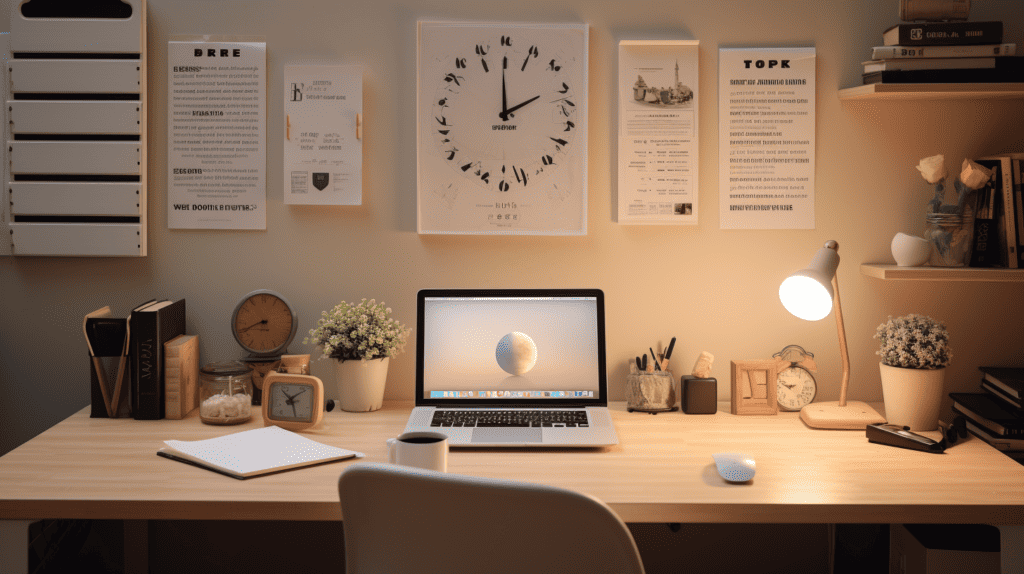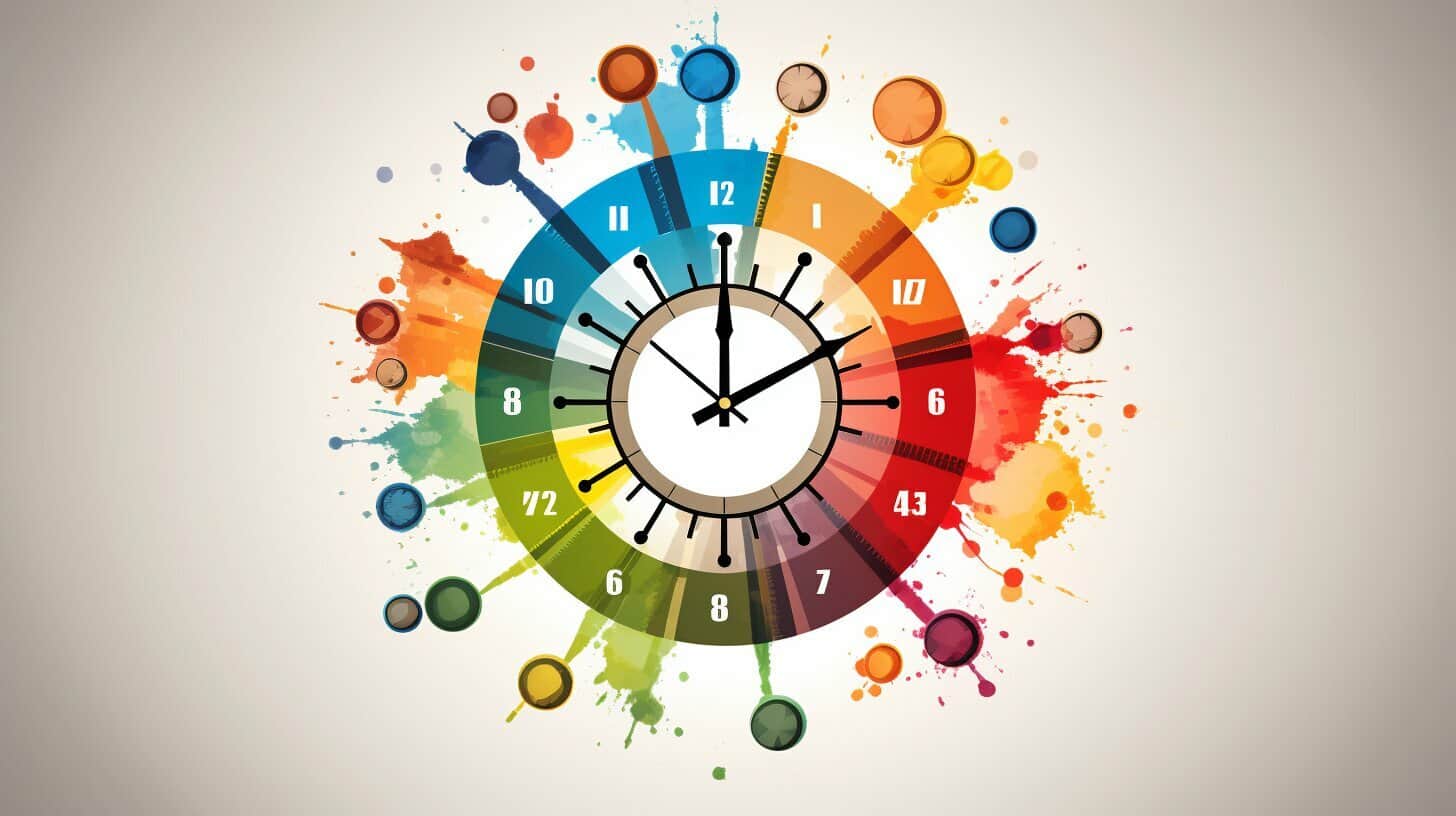As an artist, I understand the importance of time management in maximizing creativity. Whether I’m working on a commission or a personal project, efficient scheduling allows me to stay focused and productive. In this article, we’ll explore the unique challenges that artists face when it comes to managing their time effectively, and offer practical strategies and techniques to overcome them.
Key Takeaways:
- Effective time management is essential for maximizing creativity
- Artists face unique challenges in managing their time
- Balancing creativity and structured scheduling is crucial
- Tools such as time blocking and technology can be valuable for artists
- Maintaining work-life balance is important for preventing burnout
Understanding the Challenges of Time Management for Artists
As a creative professional, I know firsthand the difficulties of effective time management. Balancing the demands of a busy schedule with the need to foster creativity can be a daunting task. Here are some practical tips and techniques that I’ve found helpful in managing my time as an artist.
Understanding the Unique Challenges
Unlike other professions that follow a set routine, artists often work irregular hours and require uninterrupted blocks of time for creative pursuits. This can make it challenging to adhere to a structured schedule. Additionally, the creative process itself can be unpredictable, with ideas flowing at unexpected times or getting stuck for long periods.
To overcome these challenges, I’ve found it helpful to establish a routine that allows for flexibility. For example, I set aside certain hours of the day for creative work, but also allow for breaks or spontaneous bursts of inspiration. By embracing a flexible routine, I can maintain a balance between structure and creativity.
Effective Time Management Techniques
Another important strategy for artists is to prioritize tasks and break them down into smaller, more manageable steps. This can help make the work feel less overwhelming and prevent procrastination. I also try to allocate time for administrative tasks, such as responding to emails or updating my portfolio, to avoid becoming bogged down by these duties.
When it comes to time-tracking, I’ve found that setting realistic goals and deadlines is key. By breaking down larger projects into smaller, achievable tasks, I can keep myself on track and avoid feeling overwhelmed. Additionally, I try to utilize time-management tools, such as calendar apps or project-management software, to stay organized and efficient.
“The creative process is not like a situation where you get struck by a single lightning bolt. You have ongoing discoveries, and there’s ongoing creative revelations. Yes, it’s really helpful to be marching toward a specific destination, but, along the way, you must allow yourself room for your ideas to blossom, take root, and grow.” – Carlton Cuse
Ultimately, the key to effective time management as an artist is to strike a balance between structure and flexibility. By prioritizing tasks, setting realistic goals, and utilizing tools and techniques, artists can optimize their productivity while still nurturing their creativity.

Balancing Creativity and Time Management
As an artist, it’s important to find a balance between being in a creative flow and adhering to a structured schedule. While creativity can’t be forced, it’s also important to prioritize tasks and make the most of your time.
One effective technique is to break down larger projects into smaller, more manageable tasks. This allows you to focus on each individual step and make progress without feeling overwhelmed. It’s also important to set clear deadlines for each task to help keep yourself accountable.
Prioritizing Tasks
When prioritizing tasks, it’s helpful to determine which ones are most urgent or important. For example, if you have a commission due in a week, that task should take priority over something that can be completed later.
Another way to prioritize tasks is to consider which ones will have the biggest impact on your overall goals. For example, if your long-term goal is to have a successful art career, it may be more beneficial to spend time creating new work or marketing yourself, rather than spending hours on administrative tasks.
Ultimately, finding a balance between creativity and time management is about being intentional with your time and making the most of the hours you have. By prioritizing tasks and breaking down larger projects, you can stay productive without sacrificing your creativity.
Time Management Strategies for Creative Professionals
As a creative professional, managing your time effectively is crucial to achieving your artistic goals. To maximize your productivity and creativity, it’s important to develop efficient scheduling strategies that work for you. Here are some essential time management strategies for artists:
1. Create a Realistic Schedule
When planning your schedule, it’s important to be realistic about the amount of time you have available and the tasks you can realistically accomplish. Avoid overcommitting and schedule regular breaks to avoid burnout. Prioritize the most important tasks and focus on completing them first.
2. Utilize Time Management Tools
There are a variety of time management tools available to help artists stay organized and focused. Consider using apps like Trello or Asana to manage your tasks and deadlines. Use time tracking apps like RescueTime to analyze how you spend your time and identify areas for improvement.
3. Set Goals
Setting clear goals is essential for effective time management. Identify your long-term and short-term goals and break them down into smaller, manageable tasks. Use the SMART criteria (specific, measurable, achievable, relevant, time-bound) to ensure that your goals are achievable and realistic.
4. Eliminate Distractions
Distractions can be a major hindrance to creativity and productivity. Create a focused work environment by eliminating unnecessary distractions. Turn off your phone, shut down social media, and close your email inbox while you work.
5. Focus on Your Most Productive Hours
Everyone has times of day when they are most productive. Identify your most productive hours and schedule your most important tasks during those times. If you’re a morning person, tackle the most challenging tasks in the morning when you’re most alert and focused.
6. Take Breaks
Taking regular breaks is essential for maintaining focus and creativity. Schedule short breaks throughout your day to recharge and refocus. Take a walk, stretch, or simply step away from your work for a few moments to clear your mind and reset your focus.
By implementing these time management strategies, you can optimize your creative flow and achieve more as an artist. Remember that effective time management is an ongoing process, so continue to evaluate and adjust your schedule as needed to stay on track and achieve your goals.

Maximizing Studio Time for Artists
As an artist, time spent in the studio is invaluable to the creative process. However, it can also be easy to get distracted or lose focus, leading to unproductive sessions. Here are some tips to help you make the most of your time in the studio:
- Eliminate distractions: Turn off your phone and notifications to minimize interruptions and maintain focus.
- Set goals: Start each session with a clear goal in mind, whether it’s completing a specific piece or practicing a certain technique.
- Create a productive environment: Make sure your workspace is organized and clean, with all necessary materials within reach.
- Take breaks: It’s important to take breaks throughout your studio session to prevent burnout and maintain focus. Step outside for fresh air or stretch your legs to re-energize.
By implementing these tips, you can maximize your studio time and stay on track towards your creative goals.
The Power of Time Blocking for Artists
Time blocking is a valuable tool that can help artists optimize their productivity by allocating time for different tasks. As an artist, I have found that by breaking down my day into designated time slots for specific activities, I am able to work more efficiently and stay focused.
What is Time Blocking?
Time blocking involves scheduling a specified amount of time for a particular task. For example, an artist may allocate two hours for sketching, followed by an hour for marketing, and then four hours for painting. By having a clear understanding of how much time is available for each task, artists can work on their projects without feeling overwhelmed or distracted.
How to Effectively Use Time Blocking
To make the most out of time blocking, artists need to start by creating a realistic schedule that balances their creative needs with their other obligations. It’s important to remember to include time for breaks and downtime, as well as for unexpected interruptions or setbacks.
Once the schedule is created, it’s important to stick to it as much as possible. This means minimizing distractions and staying focused on the task at hand. Artists can also use tools such as timers and alerts to keep them on track and to ensure that they are making progress towards their goals.
When allocating time for different tasks, it’s important to prioritize the most important and time-sensitive ones first. For example, if there is a looming deadline for a commission, an artist should allocate more time towards that project than towards a personal project that can wait.
Benefits of Time Blocking for Artists
Time blocking can provide several benefits for artists, including:
- Increased productivity
- Improved focus and concentration
- Reduced stress and overwhelm
- Clearer understanding of project timelines
- Enhanced work-life balance
By using time blocking as a time management strategy, artists can reap these benefits and improve their creative flow.

Overcoming Procrastination and Time Wasting Habits
As an artist, it can be easy to get trapped in a cycle of procrastination and time-wasting habits. However, recognizing these patterns and developing strategies to overcome them is crucial for achieving maximum productivity.
One effective technique is the Pomodoro Method. This involves breaking up work into 25-minute intervals, followed by a five-minute break. This can help to combat the urge to procrastinate and maintain focus during work sessions.
Another helpful strategy is to eliminate distractions. This may mean turning off your phone or finding a quiet workspace. It can also be useful to identify specific triggers for procrastination and actively work to avoid them.
“The greatest amount of wasted time is the time not getting started.” – Dawson Trotman
Furthermore, setting realistic goals and deadlines can help to reduce the tendency to procrastinate. Breaking down larger projects into smaller, more manageable tasks can also make the creative process feel less overwhelming.
Ultimately, overcoming procrastination and time-wasting habits requires a combination of self-awareness, discipline, and effective time management strategies. With dedication and effort, artists can overcome these obstacles and unlock their full creative potential.
Collaborative Time Management for Artists
Collaboration is a key aspect of working in the creative industry, and effective time management is vital when working with others. As an artist, it is essential to communicate clearly and coordinate schedules with collaborators to optimize productivity.
Effective Communication
Clear communication is the foundation of successful collaboration and time management. It’s essential to set clear expectations and deadlines with your collaborators to avoid any confusion or misunderstandings. Always keep the project’s goals in mind and be willing to compromise to ensure everyone’s needs are met.
Coordinating Schedules
When working with others, it’s essential to coordinate schedules effectively to maximize the time spent on the project. Utilizing a scheduling tool, such as Google Calendar or Microsoft Teams, can help keep everyone on the same page and ensure that deadlines are met. Be sure to schedule regular check-ins to keep the project moving forward and address any issues promptly.
Distributing Tasks
When working with collaborators, it’s important to identify everyone’s strengths and weaknesses and divide tasks accordingly. This will help ensure that everyone is working on tasks that play to their strengths and that the project is completed efficiently. Distributing tasks also ensures that no one person is overwhelmed or bogged down with work.
Conclusion
Collaborative time management is a crucial skill for artists working in teams or with other people. Effective communication, coordinated schedules, and task distribution are key elements to ensure productivity and project success. Be sure to implement these strategies to make the most of your collaborative projects.

Leveraging Technology for Time Management
As a busy artist, it can be challenging to juggle all of your tasks and deadlines. Fortunately, technology can help streamline your time management and boost your productivity.
One useful tool is a task management app, such as Trello or Asana, which allows you to create to-do lists, set priorities, and track your progress. These apps can also be shared with team members or collaborators, enabling everyone to stay on the same page.
Another helpful app is RescueTime, which tracks how you spend your time on the computer. It provides a detailed report of where you’re wasting time and offers suggestions for improvement. By identifying your time-wasting habits, you can take steps to eliminate them and become more efficient.
Cloud storage services like Dropbox or Google Drive are also essential for artists. These platforms allow you to easily access your files from anywhere and collaborate with others in real-time. By keeping all of your work in one place, you can save time and avoid the stress of searching for misplaced files.
Finally, don’t overlook the power of social media scheduling tools like Hootsuite or Later. These services allow you to plan and schedule your social media posts in advance, freeing up time for other tasks. By staying organized and consistent with your social media presence, you can build your brand and grow your audience.
By taking advantage of these technological tools, you can optimize your time management and focus on what really matters: creating great art.
Maintaining Work-Life Balance as an Artist
As an artist, it can be easy to get lost in your work and lose sight of the importance of a healthy work-life balance. However, maintaining this balance is vital to prevent burnout and foster long-term creativity. Here are some tips to help you achieve a healthy work-life balance:
- Set boundaries: It’s important to set boundaries between your work and personal life. Define clear working hours and stick to them as much as possible. Similarly, set aside time for your personal life and make sure to disconnect from work during that time.
- Create downtime: It’s important to take breaks and give yourself time to recharge. Whether it’s a quick walk outside, a coffee break, or a weekend getaway, make sure to schedule downtime to prevent burnout.
- Manage self-care: Taking care of your physical and mental health is crucial for maintaining a healthy work-life balance. Incorporate regular exercise, healthy eating, and stress-relief practices like meditation or yoga into your routine.
Conclusion
By setting boundaries, creating downtime, and managing self-care, you can maintain a healthy work-life balance as an artist. Remember, taking care of yourself is just as important as taking care of your art.
Conclusion on Time Management for Artists
In conclusion, mastering time management is essential for artists who want to enhance their creative flow and achieve their goals. By understanding the unique challenges that artists face when it comes to managing their time effectively, and utilizing practical tips and techniques, artists can prioritize their tasks without sacrificing their creativity.
Maximizing studio time, leveraging technology, and overcoming procrastination are just a few strategies that can help artists stay focused and productive. Collaborative time management is also a valuable tool for artists who work in teams or collaborate with others.
It’s important to remember that maintaining a healthy work-life balance is crucial for preventing burnout and fostering long-term creativity. By setting boundaries, creating downtime, and managing self-care, artists can avoid exhaustion and maintain their passion for their art.
I encourage you to implement the strategies and techniques shared in this article to enhance your creative flow and achieve your artistic goals. With efficient scheduling and effective time management, you can reach your full potential as an artist.
FAQ on Time Management for Artists
Q: Why is time management important for artists?
A: Time management is crucial for artists because it helps enhance their creative flow. Efficient scheduling allows artists to maximize their productivity and make the most of their time.
Q: What are the challenges of time management for artists?
A: Artists face unique challenges when it comes to managing their time effectively. However, with effective time management techniques and artist productivity tips, these challenges can be overcome.
Q: How can artists balance creativity and time management?
A: Balancing creativity and time management is a delicate task. Artists can prioritize their tasks and find a balance between being in a creative flow and adhering to a structured schedule.
Q: What are some time management strategies for creative professionals?
A: There are specific time management strategies tailored to the needs of creative professionals. It’s important to create a realistic schedule and utilize tools that can help artists stay organized and focused.
Q: How can artists maximize their studio time?
A: To make the most of studio time, artists can eliminate distractions, set goals, and create a productive environment that fosters creativity.
Q: What is the power of time blocking for artists?
A: Time blocking is a valuable tool for artists as it helps effectively allocate time for different tasks, such as sketching, painting, marketing, and self-promotion.
Q: How can artists overcome procrastination and time-wasting habits?
A: Common pitfalls like procrastination and time-wasting habits can hinder an artist’s productivity. Practical strategies and techniques can help artists overcome these challenges and stay focused.
Q: How can collaborative time management benefit artists?
A: Collaborative time management is beneficial for artists who work in teams or collaborate with others. Effective communication and coordination of schedules can optimize productivity.
Q: What technological tools can artists leverage for time management?
A: Artists can leverage various technological tools and apps for effective time management. These tools streamline tasks, manage deadlines, and improve overall productivity.
Q: How can artists maintain work-life balance?
A: Maintaining a healthy work-life balance is essential for artists. Setting boundaries, creating downtime, and managing self-care can prevent burnout and foster long-term creativity.





Leave a Reply